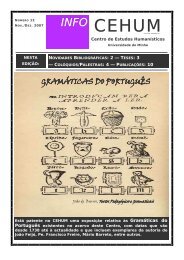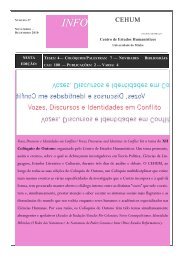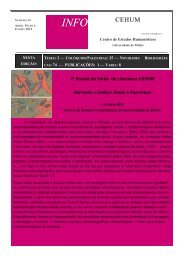Diacritica 25-2_Filosofia.indb - cehum - Universidade do Minho
Diacritica 25-2_Filosofia.indb - cehum - Universidade do Minho
Diacritica 25-2_Filosofia.indb - cehum - Universidade do Minho
Create successful ePaper yourself
Turn your PDF publications into a flip-book with our unique Google optimized e-Paper software.
172<br />
GEORGINA ABREU<br />
From the point of view of early nineteenth-century print culture,<br />
Hone’s satires represented a breakthrough. In Aspersions Answered (Hone,<br />
1824: 49), Hone claimed that his ‘little pieces’ had created ‘a new era in<br />
the history of publication’ by combining engraving on wood and type on a<br />
single page, which enabled the production of cheap illustrated texts. Hone<br />
a<strong>do</strong>pted this innovation in the 1819 satire Th e Political House that Jack<br />
Built (Hone, 1971: 35-58), with great success, and used it again in 1820 in<br />
two equally successful pamphlet satires Th e Queen’s Matrimonial Ladder, A<br />
National Toy (Hone, 1971:167-85) and Non Mi Ricor<strong>do</strong>! (Hone, 1971: 193-<br />
205), composed in partnership with George Cruikshank.<br />
Th e Queen’s Matrimonial Ladder was published in early August 1820,<br />
and ran to forty-four editions in the four months aft er its publication. It<br />
also came out in two French editions and, like most Hone’s satires, inspired<br />
numerous loyalist imitations (Wood, 1994: 172; Bowden, 1975, 320-2). [18]<br />
Th e theme of the wronged wife reached one of its most successful versions<br />
in the satiric depiction of a decadent, debauched King, ‘a burning shame’,<br />
and a Parliament dubbed as the ‘House of Incurables’. Th e line, ‘I shall get<br />
rid of her, and I’ll then get another!’ (179) refl ects the opinion that George<br />
IV was a capricious, deceitful husband, moved by selfi sh reasons and not<br />
by moral principles. Cruikshank’s design for the concluding section, ‘Degradation’,<br />
shows a disgraced George IV ‘exposed [...] for all men to see’ and<br />
turned into a victim of ‘the laughter of triumph, the jeers of the world’<br />
(185).<br />
Th e satiric depiction of the King and of the prosecutors of the Queen is<br />
also carried out in celebration of the press, symbolised by a printing-press<br />
depicted inside an eye, the eye of God, who sees everything. It ‘sees the rat<br />
Leech [Leach, Vice-Chancellor] turn towards Milan’s walls, [...] / sees Him,<br />
for who they work the treacherous task, / With face, scarce half conceal’d,<br />
behind their mask’. Th e King is ‘fat, fi ft y-eight, and frisk, still a beau [...] /<br />
Led by a passion, prurient, blind, and batter’d, / lame, bloated, pointless,<br />
fameless, age’d and shatter’d / creeping, like Guy Fawkes, to blow up his wife’<br />
(181). Th e press is ‘our moral sun’ and a source of knowledge and power.<br />
Th e image of the printing press inside an eye is directly linked to the<br />
eighteenth-century print satires developed out of the Gunpowder plot and<br />
18 Th e Radical Ladder (Anon., 1971: 211-35) was one of them. It was published in October 1820<br />
and printed for the ‘Loyal Association’ to ‘Th e Loyalist and Anti-Radical Magazine’. It is a longer<br />
text than the radical satire (24 pages, whereas Hone’s satire has 18), but it has only one illustration<br />
on the frontispiece, by George Cruikshank in which the Queen, followed by the radicals, is<br />
at the top of the ladder setting fi re to the crown, the head of the political system.<br />
<strong>Diacritica</strong> <strong>25</strong>-2_<strong>Filosofia</strong>.<strong>indb</strong> 172 05-01-2012 09:38:28











![Programa [pdf] - cehum - Universidade do Minho](https://img.yumpu.com/17305425/1/190x135/programa-pdf-cehum-universidade-do-minho.jpg?quality=85)




